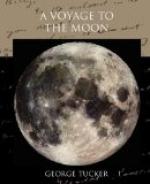The master now made his appearance, and learning our errand, was very communicative. He descanted on the advantages of this manual, and ocular mode of teaching the science of numbers, and gave us practical illustrations of its efficacy, by examining his pupils in our presence. He told the first boy he called up, and who did not seem to be more than seven or eight years of age, to add 5, 3, and 7 together, and tell him the result. The little fellow set about hunting, with great alacrity, over his bag, until he found a piece divided like three fingers, then a piece with five divisions, and lastly, one with seven, and putting them side by side, he found the piece of a correspondent length, and thus, in less than eight minutes and a half, answered, “fifteen.” The ingenious master then exercised another boy in subtraction, and a third in multiplication: but the latter was thrown into great confusion, for one of the pieces having lost a division, it led him to a wrong result.
The teacher informed us that he taught geometry in the same way, and had even extended it to grammar, logic, rhetoric, and the art of composition. The rules of syntax were discovered by pieces of wood, interlocking with each other in squares, dovetails, &c., after the manner of geographical cards; and as they chanced to fit together, so was the concordance between the several parts of speech ascertained. The machine for composition occupied a large space; different sets of synonymes were arranged in compartments of various sizes. When the subject was familiar, a short piece was used; when it was stately or heroic, then the longest slips that could be found were resorted to. Those that were rounded at the ends were mellifluous; the jagged ones were harsh; the thick pieces expressed force and vigour. Where the curves corresponded at one end, they served for alliteration; and when at the other, they answered for rhyme. By way of proving its progress, he showed us a composition by a man who was deaf and dumb, in praise of Morosofia, who, merely by the use of his eyes and hands, had made an ingenious and high-sounding piece of eloquence, though I confess that the sense was somewhat obscure. We went away filled with admiration for the great Lozzi Pozzi’s inventions.
Having understood that there was an academy in the neighbourhood, in which youths of maturer years were instructed in the fine arts, we were induced to visit it; but there being a vacation at that time, we could see neither the professors nor students, and consequently could gain little information of the course of discipline and instruction pursued there. We were, however, conducted to a small menagerie attached to the institution, by its keeper, where the habits and accomplishments of the animals bore strong testimony in favour of the diligence and skill of their teachers.




